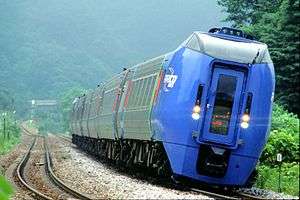KiHa 283 series
| KiHa 283 series | |
|---|---|
|
KiHa 283 series on a Super Hokuto service, June 2001 | |
| In service | 1997–Present |
| Manufacturer | Fuji Heavy Industries |
| Constructed | 1995–2001 |
| Number built | 63 vehicles |
| Number in service | 57 vehicles |
| Number scrapped | 6 vehicles (accident damage) |
| Formation | 5-9 cars per trainset |
| Operator(s) | JR Hokkaido |
| Depot(s) | Sapporo |
| Line(s) served | Hakodate Main Line, Nemuro Main Line, Sekishō Line |
| Specifications | |
| Car body construction | Stainless steel |
| Car length | 21,300 mm (69 ft 11 in) |
| Width | 2,840 mm (9 ft 4 in) |
| Height | 4,050 mm (13 ft 3 in) |
| Doors | 1 per side |
| Maximum speed | 130 km/h (80 mph) |
| Prime mover(s) | N-DMF11HZA (355 hp) x2 per car |
| Transmission | Hydraulic |
| Track gauge | 1,067 mm (3 ft 6 in) |
The KiHa 283 series (キハ283系) is a tilting diesel multiple unit (DMU) train type operated by Hokkaido Railway Company (JR Hokkaido) on limited express services in Hokkaido, Japan, since 1997.[1] They were based on the KiHa 281 series trains introduced in 1994.[2]
Operations
KiHa 283 series trainsets are used on the following services.[2]
- Super Ōzora services between Sapporo and Kushiro, since 22 March 1997
- Super Hokuto services between Hakodate and Sapporo, since April 1998
- Super Tokachi services between Sapporo and Obihiro, since 11 March 2000
History
A three-car pre-production set was delivered from Fuji Heavy Industries in 1995 for evaluation and testing.[1]
20 production vehicles were delivered from 1996,[1] with the first trains introduced on Super Ōzora services between Sapporo and Kushiro from the start of the revised timetable on 22 March 1997.[2]
A further batch of 12 vehicles was delivered to coincide with the introduction of KiHa 283s on Super Hokuto services between Hakodate and Sapporo, operating alongside the KiHa 281 series sets.[1]
KiHa 283 series sets were also introduced on some Super Tokachi services between Sapporo and Obihiro from 11 March 2000.[2]
2011 Sekishō Line derailment and fire
On 27 May 2011, a 6-car KiHa 283 series train was destroyed by fire after it derailed and made an emergency stop inside the 685 metre-long No. 1 Niniu Tunnel on the Sekishō Line in Shimukappu, Hokkaidō, at around 21:55, while forming the Super Ōzora 14 service from Kushiro to Sapporo.[3][4] The train was formed as follows, with car 1 at the Kushiro end. All cars were gutted by fire,[4] and were officially withdrawn on 30 June 2011.[5]
| Car No. | 1 | 2 | 3 | 4 | 5 | 6 |
|---|---|---|---|---|---|---|
| Number | KiHa 283-1 | KiHa 282-3001 | KiRo 282-7 | KiHa 282-1 | KiHa 282-101 | KiHa 283-9 |
References
- 1 2 3 4 JR全車輌ハンドブック2009 [JR Rolling Stock Handbook 2009]. Japan: Neko Publishing. 2009. pp. 452–453. ISBN 978-4-7770-0836-0.
- 1 2 3 4 Haraguchi, Takayuki (2009). Encyclopedia of JR's Railway Cars: JR全車輌. Japan: Sekai Bunka. p. 111. ISBN 978-4-418-09905-4.
- ↑ 石勝線清風山信号場構内で発生した列車脱線事故について [Details of Sekisho Line Derailment] (pdf). Press release (in Japanese). Japan: Hokkaido Railway Company. 28 May 2011. Retrieved 14 January 2012.
- 1 2 事業改善命令・改善指示に対する報告について [Report on Corporate Improvement Directions] (pdf). Press release (in Japanese). Japan: Hokkaido Railway Company. 16 September 2011. Retrieved 14 January 2012.
- ↑ JR電車編成表 2012冬 [JR EMU Formations - Winter 2012]. Japan: JRR. October 2011. p. 359. ISBN 978-4-330-25611-5.
External links
| Wikimedia Commons has media related to KiHa 283 series. |
- JR Hokkaido KiHa 283 Super Ōzora train information (Japanese)
- JR Hokkaido KiHa 281/283 Super Hokuto train information (Japanese)
- JR Hokkaido KiHa 261/283 Super Tokachi train information (Japanese)
